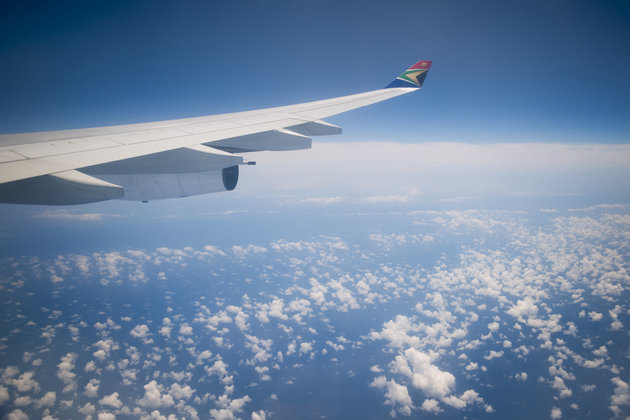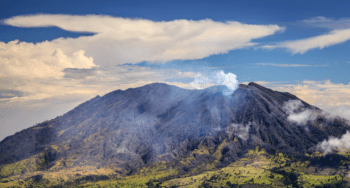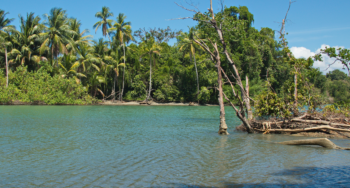Costa Rica Domestic Flights: What's Covered
Costa Rica’s domestic flights save 3-8 hours on remote routes where mountain roads turn 100km into 4-hour drives. Sansa and Green Airways operate 20-50 minute flights from San José to 10+ destinations—costing $80-160 one-way with strict 30-pound baggage limits. Combining flights with rental cars works best: fly to your farthest destination first, then drive back.
Quick Facts:
- Manuel Antonio saves 3 hours; Arenal saves 3 hours; Osa Peninsula saves 6-8 hours versus driving
- Book 1-2 months ahead during high season; 2-3 weeks during green season
- Morning flights offer smoother conditions—afternoons see more turbulence from thermal activity
- 12-14 seat planes require weighing passengers with luggage for proper aircraft balancing
- Rental car delivery fees to airports range $55-270 by location
Top 5 Routes Where Flights Make Sense:
- Osa Peninsula (Puerto Jiménez/Drake Bay) – 50-minute flight versus 6-8 hours on deteriorating roads
- Tortuguero – Boat or plane access only; 30-minute flight beats 3-hour drive plus 2-hour boat
- Southern Nicoya (Tambor) – 25-minute flight versus 5-6 hours drive/ferry with unpredictable waits
- Tamarindo – 45-minute flight saves 4.5 hours for Guanacaste beach access
- Nosara – 40-minute flight versus 4.5-5 hours, including unpaved roads, challenging in the rain
If you need any help with a Costa Rica car rental, contact us now!
You know that feeling when you look at a map of Costa Rica and think “it’s so small, we can drive everywhere!”? Then you start researching actual drive times and realize that a 100km journey somehow takes 4 hours? Yeah, that’s when domestic flights start looking pretty attractive.
I’ve spent years helping travelers figure out when flying beats driving in Costa Rica, and honestly, it’s not always obvious. Those gorgeous mountains that make this country so stunning? They also turn what should be straight roads into endless switchbacks. Let me walk you through exactly when those small planes are worth it and when you’re better off enjoying the drive.
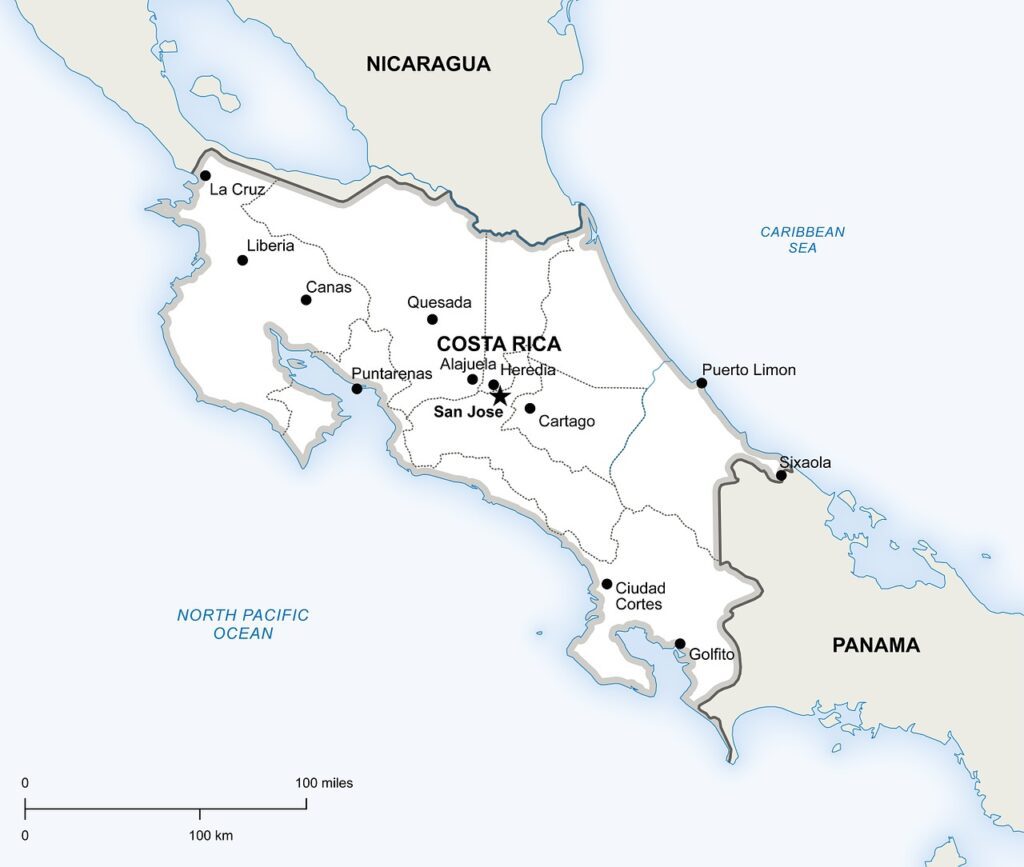
Why Would You Even Need a Flight in Such a Small Country?
Here’s the thing about Costa Rica that catches everyone off guard – it’s roughly the size of West Virginia or Denmark, but getting from point A to point B can take forever. The trip from San José to Tamarindo? That’s 259 km that’ll eat up 5 hours of your vacation. And that’s on a good day with decent traffic.
The domestic flight network exists because sometimes the alternative is genuinely exhausting. Those beautiful mountains that create Costa Rica’s stunning landscapes and diverse microclimates? They also make for winding roads with endless switchbacks and reduced speed limits that turn simple distances into day-long journeys.
What Makes Costa Rican Travel Times So Unpredictable?
Let’s break down what you’re really dealing with:
- Mountain roads with more curves than a roller coaster – The road to Monteverde, for instance, includes about 20km of unpaved track that’ll shake your teeth loose
- Seasonal conditions that turn decent roads into adventures – During green season (May-November), afternoon rains can make certain routes particularly interesting
- Natural obstacles everywhere – Some areas have bridges that only accommodate one car at a time
- Limited highway infrastructure – Outside the main San José to Guanacaste corridor, true highways are rare
A journey that looks like a quick 100 km hop on the map can easily become a 4-5 hour drive. The trip from San José to Drake Bay? That’s technically driveable, but we’re talking 6-8 hours on progressively deteriorating roads. By the time you arrive, you’ll need a vacation from your vacation.
When Do Domestic Flights Actually Make Sense?
After watching thousands of travelers navigate this decision, here are the three scenarios where flights consistently win:
Your vacation is 10 days or less – Every hour in a car is an hour not spent in a hot spring, on a beach, or watching monkeys. When you’ve only got a week, spending 20% of it driving doesn’t make sense.
Your destination is genuinely remote – Some places like Tortuguero literally don’t have roads. Others like Drake Bay technically do, but after hour five of bouncing along dirt tracks, you’ll wish they didn’t.
The green season has arrived – Those afternoon downpours that make everything lush and green? They also make certain roads particularly challenging, especially in mountainous areas where visibility drops and roads get slippery.

Where Can You Actually Fly To? Costa Rica's Complete Domestic Airport Network
Costa Rica operates a surprisingly extensive network of small regional airports. Some are decent little facilities with actual buildings and services. Others are, well, let’s just say “rustic.” Here’s what you’re really getting into at each one.
Tobías Bolaños International Airport (SYQ) – Your San José Domestic Hub
This isn’t the airport you flew into internationally – that’s Juan Santamaría (SJO). Tobías Bolaños sits in the Pavas neighborhood of San José, about 7 km west of downtown and roughly 20 minutes from SJO depending on traffic.
What nobody tells you about this airport:
- Located in Pavas, about 20 minutes from SJO (but could be 40 minutes in traffic)
- The snack bar prices will make your eyes water – seriously, bring your own snacks
- No ATMs inside the terminal – grab cash beforehand
- Basic waiting area with charging stations for phones and laptops
- Limited parking available if you’re driving yourself
- Small terminal means minimal walking but also minimal services
Getting between airports: If you’re connecting from an international flight at SJO, you’ll need to arrange transportation between the two airports. Taxi fare typically runs $25-30 and takes 20-30 minutes depending on traffic. Some domestic airlines offer shuttle service between airports for an additional fee, but confirm this when booking. Rush hour traffic (7-9 AM and 4-7 PM) can double your transit time.
Quepos/Manuel Antonio Airport (XQP) – Your Shortcut to the Central Pacific
This small but busy airport serves one of Costa Rica’s most popular destinations: Manuel Antonio National Park and its surrounding beaches. Twenty minutes in a small plane versus three hours on mountain roads? This flight makes total sense if Manuel Antonio is high on your priority list.
The real deal about this airport:
- Located 5 km from downtown Quepos and about 10 km from Manuel Antonio
- Approximately 20-minute flight from San José saves you a 3-hour drive
- Small open-air terminal with minimal facilities – basically a covered waiting area
- Serves the entire Central Pacific region including Dominical to the south
- Pick up a rental car here and you’re at the beach in 15 minutes
Why this flight works: The drive from San José to Manuel Antonio takes approximately 3 hours through mountains and along winding coastal roads. While scenic, it can be tiring, especially if you’re arriving after an international flight. Flying cuts this down to 20 minutes, giving you almost a full extra day at the beach.
Tambor Airport (TMU) – Gateway to the Southern Nicoya Peninsula
Want to reach Santa Teresa, Montezuma, or Mal País without the whole ferry schedule dance? Tambor is your answer. This airport serves as the gateway to the southern Nicoya Peninsula, one of Costa Rica’s most beautiful but hardest-to-reach regions.
What to expect at Tambor:
- Located near Tambor Beach on the southern Nicoya Peninsula
- 25-minute flight from San José versus a 5-6 hour drive/ferry combination
- Basic facilities with a small covered waiting area
- Services the entire southern peninsula region
Why fly here: Getting to Santa Teresa or Montezuma by road requires either a very long drive around the entire peninsula (5-6 hours) or a combination of driving and ferry crossing. The ferry, while scenic, runs on a fixed schedule and can have lengthy wait times during high season – sometimes 2-3 hours just to board. Flying to Tambor and then driving 45 minutes to Santa Teresa can save you half a day of travel time.
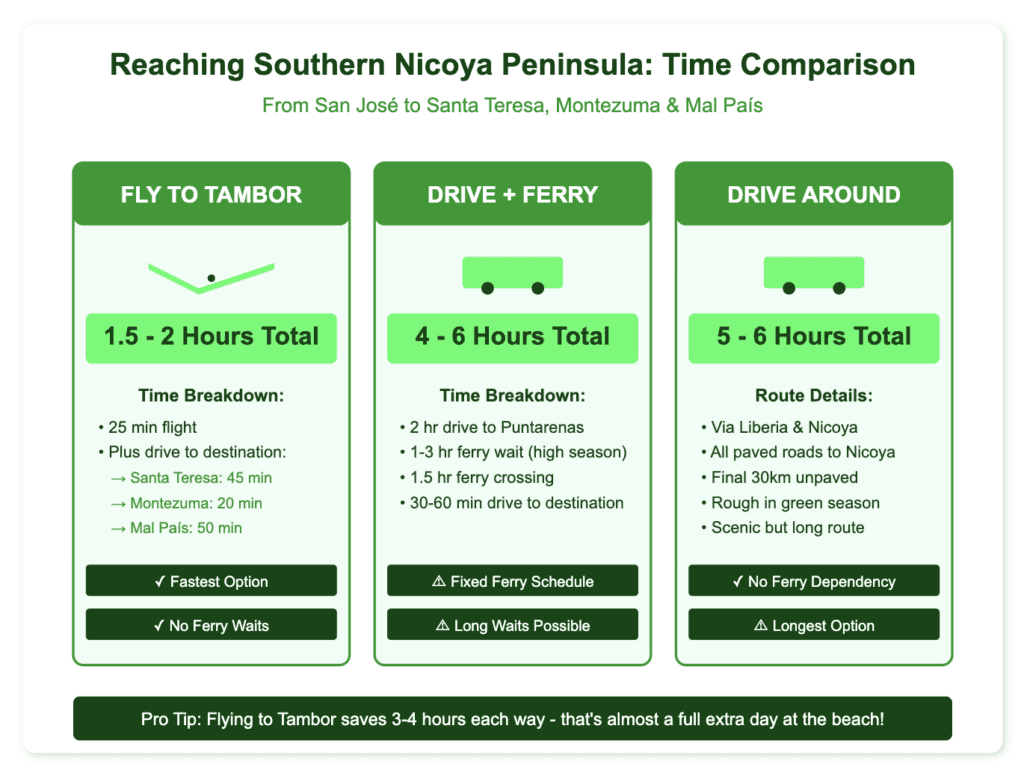
La Fortuna/Arenal Airport (FON) – Direct Access to Volcano Country
This airport serves the popular Arenal Volcano and La Fortuna region, known for hot springs, adventure activities, and those stunning volcano views everyone wants to Instagram.
Airport specifics:
- Located about 7km from downtown La Fortuna
- 30-minute flight from San José saves a 3-hour mountain drive
- Very basic facilities – think covered area with benches
- Operates weather permitting (morning clouds can delay flights)
- Rental car pickup available for exploring the region
Weather warning: This region is known for its cloud cover, especially in the afternoons. Morning flights have better odds of operating on schedule. During the rainiest months (September-October), delays are more common. Always have a backup plan.
Tamarindo Airport (TNO) – Beach Access for SJO Arrivals
Serving the popular beach town of Tamarindo and surrounding Guanacaste beaches like Playa Conchal, Flamingo, and Potrero.
What you’ll find:
- Located right at the edge of Tamarindo town
- 45-minute flight from San José beats the 4.5-hour drive
- Basic open-air terminal with minimal shade
- Walking distance to some accommodations
- Perfect for accessing multiple beach towns
Strategic value: While many visitors fly internationally into Liberia (LIR) to access Guanacaste beaches, those arriving at SJO can save the 4.5-hour drive by taking this quick domestic flight instead. You’ll be on the beach with a cold drink in hand while others are still navigating mountain roads.
Nosara Airport (NOB) – The Yoga and Surf Retreat Shortcut
This small airstrip serves the increasingly popular yoga and surf community of Nosara on the Nicoya Peninsula.
Airport details:
- Located about 2 km from Nosara’s main area of Guiones
- 40-minute flight from San José versus 4.5-5 hours driving
- Very basic facilities – essentially a landing strip with a small shelter
- Service can be seasonal with more flights during high season
Why it matters: Nosara has blown up in popularity but remains relatively remote. The drive from San José takes about 4.5-5 hours, with the final stretch on unpaved roads that can be rough. During the green season, these roads can become challenging, making the 40-minute flight particularly valuable.
Puerto Jiménez (PJM) and Drake Bay (DRK) – Your Osa Peninsula Gateways
These two airports serve as the main gateways to the Osa Peninsula and Corcovado National Park, one of Costa Rica’s most biodiverse and remote regions.
Puerto Jiménez specifics:
- Located at the eastern edge of the Osa Peninsula
- 50-minute flight from San José versus 6-8 hours driving
- Basic terminal with restrooms and covered waiting area
- Main access point for Corcovado’s eastern entrances
Drake Bay specifics:
- Located near the northern coast of the Osa Peninsula
- 45-minute flight from San José
- Minimal facilities – basically a landing strip
- Many lodges provide transportation from the airstrip
- Some areas around Drake Bay aren’t accessible by regular car at all
The reality check: The Osa Peninsula is one of Costa Rica’s most remote yet rewarding destinations. Driving from San José takes 6-8 hours on progressively deteriorating roads. Some areas, particularly around Drake Bay, require 4WD vehicles and even then can be impassable during heavy rains. Flying isn’t just convenient here – it’s often the only practical option.
Tortuguero Airport (TTQ) – The Canal Network Gateway
This unique airport serves Tortuguero National Park on the northern Caribbean coast, an area famous for sea turtle nesting and canal networks often called “Costa Rica’s Amazon.”
What makes this airport special:
- Located near Tortuguero village
- 30-minute flight from San José
- Very basic facilities – just a landing strip really
- No road access to Tortuguero at all – you can only arrive by boat or plane
- Most lodges coordinate boat transfers from the airstrip
Why you fly: Tortuguero is one of Costa Rica’s most unique destinations, but it’s also one of the most challenging to reach. The standard route involves a 3-hour drive from San José followed by a 1-2 hour boat ride through canals. Flying cuts this journey to just 30 minutes, though you’ll still need a short boat transfer to reach most lodges. During turtle nesting season (July-October), flights book up quickly.
Limón International Airport (LIO) – Caribbean Coast Alternative
While primarily serving as a small international gateway, Limón also handles domestic flights and provides access to Costa Rica’s Caribbean coast.
Airport overview:
- Located just outside the city of Limón
- 30-minute flight from San José versus 3-hour drive
- Better facilities than most domestic airports with actual waiting room
- Services the central and southern Caribbean coast region
Strategic use: Though less commonly used by tourists than other domestic airports, flights to Limón can be useful for accessing Caribbean destinations like Cahuita and Puerto Viejo without the 3-4 hour drive from San José through the mountains of Braulio Carrillo National Park.
Golfito Airport (GLF) – Southern Zone Access
This small airport serves the southern Pacific region near the Panama border.
Key details:
- Located in Golfito on the Golfo Dulce
- 50-minute flight from San José
- Services sport fishing lodges and eco-resorts
- Alternative access to southern Osa Peninsula
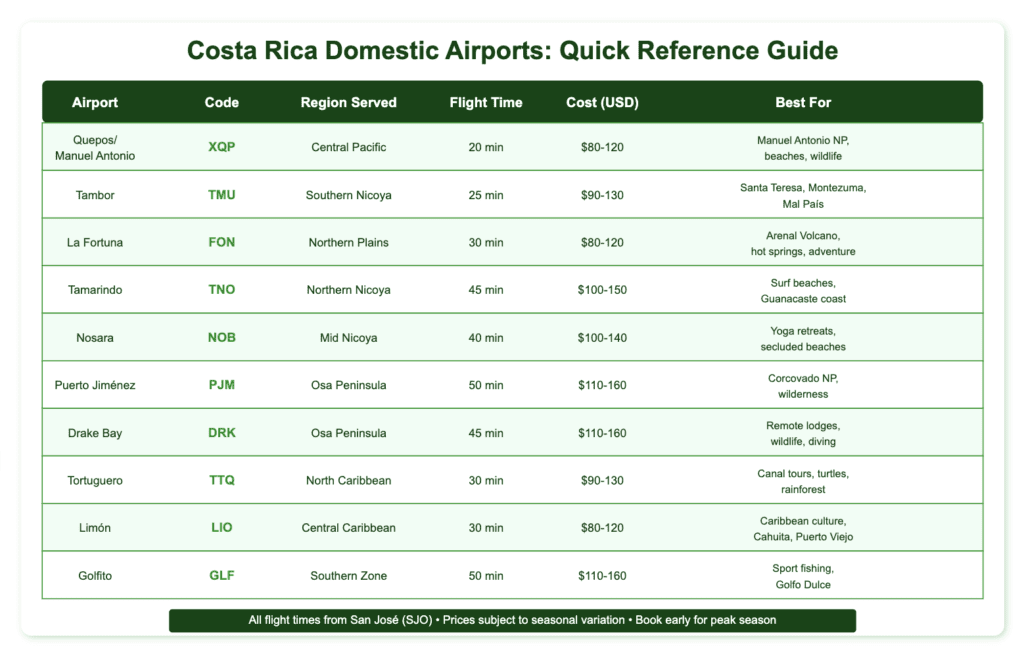
Prices and flight times are approximate and subject to change. Always check with airlines for current information.
Who Actually Operates These Flights?
Two main carriers dominate Costa Rica’s domestic flight network, and understanding their differences helps you make better booking decisions.
Sansa Airlines – The Established Player
Sansa is Costa Rica’s largest domestic carrier, operating a fleet of Cessna Grand Caravan aircraft that seat 12-14 passengers.
What you need to know about Sansa:
- Most extensive route network covering all major tourist destinations
- Operates primarily from Tobías Bolaños Airport in San José
- More frequent daily flights than competitors
- Online booking available at Sansa Airlines
- Generally reliable but weather-dependent like all small aircraft operations
- Baggage allowance: 30 pounds (14kg) total including carry-on items
- Excess baggage fees apply and are strictly enforced (about $1-2 per pound)
Costa Rica Green Airways – The Growing Alternative
A newer airline offering scheduled flights and charter services with a mix of aircraft including Daher Kodiak, Britten Norman Islander, and Cessna 208B Grand Caravan (7-12 passengers depending on the aircraft).
What sets Green Airways apart:
- Growing route network with focus on popular tourist destinations
- Flies to Nosara, Quepos, Tambor, Puerto Jiménez and other key spots
- Operates from Tobías Bolaños Airport in San José
- Books through Green Airways
- Similar baggage restrictions to Sansa
- Often markets itself as a more premium experience
- Sometimes offers charter flights for groups
Should You Book Flights Now or Wait? The Timing Strategy
Domestic flight booking in Costa Rica doesn’t follow the usual airline pricing patterns you might expect. Here’s what actually affects availability and pricing:
High Season Booking (December-April)
During Costa Rica’s dry season, domestic flights see heavy demand from both international tourists and locals on vacation:
- Regular high season: Book 1-2 months in advance
- Christmas/New Year’s weeks: Book 3+ months ahead or risk missing out
- Easter Week (Semana Santa): Also requires 3+ months advance booking
- Weekends: Fill up faster than weekdays year-round
Green Season Strategy (May-November)
The rainy season sees less overall demand but certain routes remain popular:
- Most routes: 2-3 weeks advance booking is sufficient
- Tortuguero flights: Book early regardless of season due to limited alternatives
- Osa Peninsula routes: Also maintain steady demand year-round
- September-October: The rainiest months might see more cancellations but also more availability
What Will These Flights Actually Cost?
Let’s talk real numbers so you can budget appropriately:
Short routes (20-30 minutes):
- San José to La Fortuna: $80-120 one-way
- San José to Quepos: $80-120 one-way
- San José to Tortuguero: $90-130 one-way
Medium routes (35-45 minutes):
- San José to Tamarindo: $100-150 one-way
- San José to Nosara: $100-140 one-way
- San José to Tambor: $90-130 one-way
Longer routes (45-50 minutes):
- San José to Puerto Jiménez: $110-160 one-way
- San José to Drake Bay: $110-160 one-way
- San José to Golfito: $110-160 one-way
Prices fluctuate based on season, advance booking, and remaining availability. Unlike international flights, last-minute domestic flights don’t get cheaper – they get more expensive or sell out entirely.
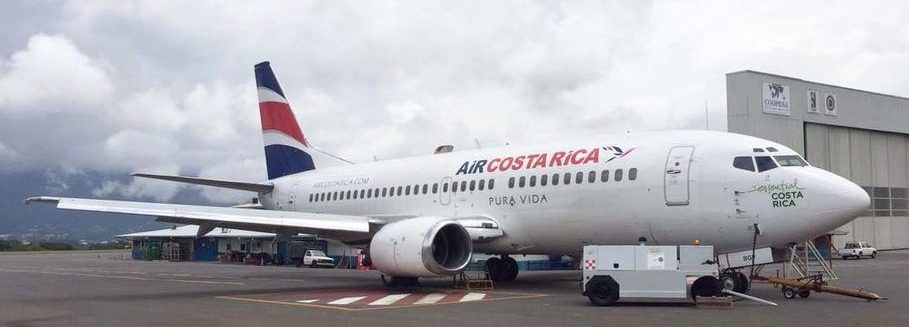
What's It Really Like Flying in These Small Planes?
Let’s be completely honest about what you’re signing up for when you book a domestic flight in Costa Rica. This isn’t your typical commercial jet experience.
The Aircraft Reality Check
You’ll be flying in small, single-engine propeller planes:
- Typical capacity: 12-14 seats (some as small as 7)
- Single propeller: Yes, you’ll hear and feel it
- Low altitude: Usually flying at 8,000-10,000 feet
- Non-pressurized: Your ears might pop a bit
- No flight attendants: The pilot is your entire crew
The Actual Experience
Check-in process: Arrive at least 45 minutes early for domestic flights. You’ll be weighed (yes, you personally) along with your luggage. This isn’t about judgment – it’s about properly balancing the small aircraft.
Baggage reality: That 30-pound limit is strict. Your bag also needs to be soft-sided if possible, as hard suitcases often don’t fit in the small cargo holds. Many lodges will store excess luggage, or you can leave it at your San José hotel.
The flight itself: You’ll feel every air pocket and weather change more than in a large plane. Morning flights typically offer smoother air. Afternoon flights, especially during green season, can be bumpy as thermal activity increases.
The views: This is the payoff – you’re flying low enough to actually see the landscape in detail. Volcanoes, coastlines, forest canopy – it’s all visible and spectacular when weather cooperates.
Tips for Nervous Flyers
If small planes make you nervous, here’s what helps:
- Book morning flights – Generally smoother air conditions
- Sit up front – Less movement and you can see what the pilot sees
- Choose your side strategically – Right side for coastal views flying south, left side for mountain and volcano views
- Expect the movement – These planes move more than jets, and that’s normal
- Focus on the destination – Remember you’re saving hours of challenging driving
How Do Smart Travelers Combine Flights with Rental Cars?
One of the most effective travel strategies in Costa Rica involves combining domestic flights with strategic car rentals.
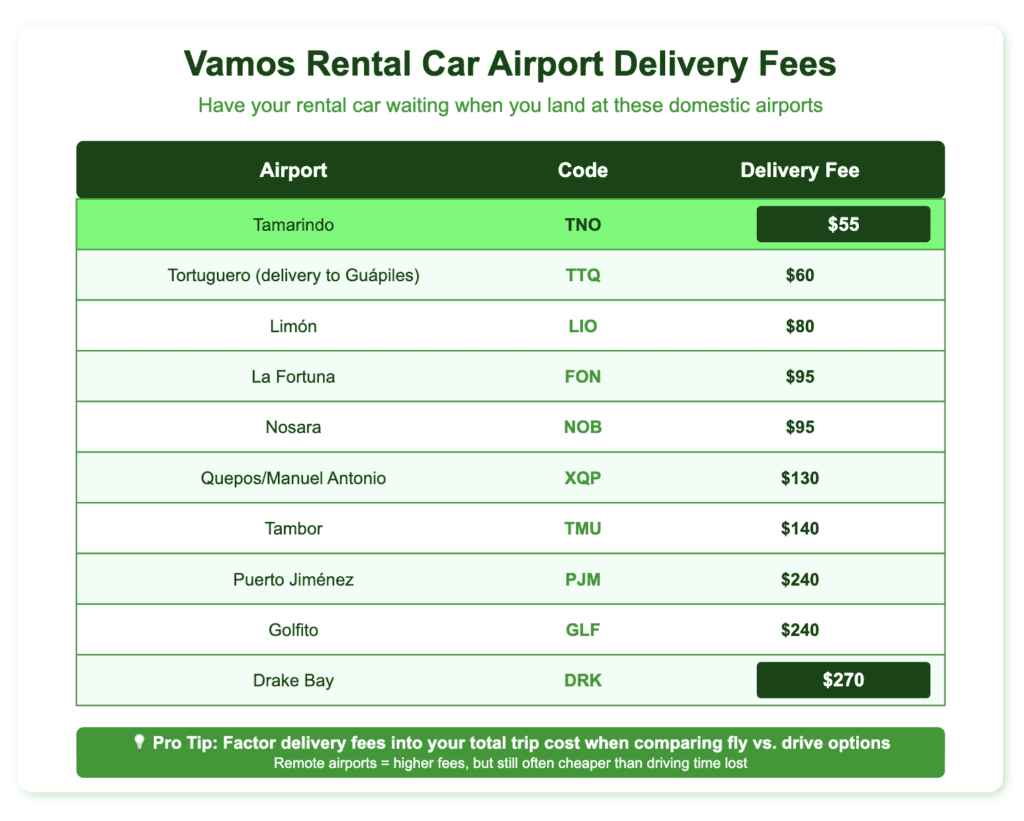
Here’s how to make this work for different types of trips:
Strategy 1: The Time-Maximizer Approach
Fly to your farthest destination first, then rent a car and drive back toward San José, exploring along the way.
Sample itinerary that works:
- Arrive at SJO International Airport
- Transfer to domestic airport and fly to Puerto Jiménez (saving 7 hours of driving)
- Spend 3 days exploring Corcovado National Park using lodge transportation
- Fly back to Quepos (20-minute flight)
- Pick up rental car at Quepos Airport
- Enjoy Manuel Antonio for 2-3 days with your car for beach hopping
- Drive to Arenal/La Fortuna (3.5 hours of scenic mountain roads)
- Explore Arenal region for 3 days (car essential for hot springs access)
- Easy 3-hour drive back to San José
- Return car and depart from SJO
This approach eliminates the longest, most challenging drive (San José to Osa Peninsula) while keeping the scenic, manageable routes.
Strategy 2: The Remote Access Plan
Use flights specifically for hard-to-reach destinations while driving in regions with good roads and spread-out attractions.
How this works in practice:
- Arrive at SJO International Airport
- Rent car immediately for Central Valley exploration
- Drive to Arenal/La Fortuna (3 hours) and explore for 3 days
- Return car at La Fortuna
- Fly from La Fortuna to Tamarindo (45 minutes vs 3.5-hour drive)
- Pick up another rental car in Tamarindo
- Beach hop through Guanacaste for 4-5 days
- Return car at Tamarindo
- Fly back to San José for departure
Strategy 3: The Peninsula-Hopper Special
Costa Rica’s two main peninsulas (Nicoya and Osa) are notorious for long drives. Use flights to skip the Peninsula perimeter roads entirely.
Smart peninsula itinerary:
- Arrive at SJO International Airport
- Fly directly to Tambor (25 minutes)
- Pick up rental car for southern Nicoya Peninsula exploration
- Enjoy Santa Teresa, Montezuma, and Mal País with your car
- Return car at Tambor after 4 days
- Fly to Drake Bay (connecting through San José)
- Use lodge transportation for Osa Peninsula adventures
- Fly back to San José for departure
This strategy is particularly valuable during green season when peninsula roads can become extra challenging.

What Nobody Tells You About Making These Connections Work
After years of watching travelers navigate this system, here are the insider tips that nobody puts in the official guides:
International to Domestic Connection Realities
If you’re connecting from an international flight to a domestic one, here’s your real timeline:
- Immigration at SJO: 30-90 minutes depending on arrival time
- Baggage claim: 20-30 minutes (bags come out slowly)
- Customs: 10-15 minutes if green light, 30+ if selected for inspection
- Airport transfer: 30 minutes minimum between SJO and Pavas
- Domestic check-in: Arrive 45-60 minutes before flight
Bottom line: Allow minimum 3 hours between international arrival and domestic departure. Four hours is safer during peak season.
Weather Wisdom That Matters
Costa Rica’s weather patterns directly affect flight reliability:
- Best months: January through April (dry season = reliable flights)
- Challenging months: September and October (peak rainfall except Caribbean)
- Daily patterns: Mornings are almost always better than afternoons
- Regional variations: Caribbean flights might operate when Pacific routes are grounded
Always book refundable accommodations when flying during September-October, and keep your schedule flexible.
Documentation and Preparation Tips
Despite being domestic flights, preparation matters:
- Always bring your passport – It’s required for all flights
- Print confirmations – Rural airports don’t always have good internet
- Confirm 24 hours ahead – Especially during green season
- Keep airline phone numbers handy – WhatsApp often works best
- Screenshot your booking – Works when internet doesn’t

When Should You Definitely Fly vs. When Should You Drive?
Let me break this down into clear scenarios based on real travel patterns:
Take the Flight When:
You’re visiting the Osa Peninsula or Tortuguero – These destinations almost always justify flying. The alternatives are genuinely exhausting.
Your vacation is 10 days or less – When time is precious, spending it in transit doesn’t make sense. Those 6-hour drives add up fast.
You’re traveling September-November to remote areas – Peak rainy season makes certain roads genuinely challenging. Why risk it?
The time saved is worth more than the cost – If you’re paying $3,000+ for your Costa Rica vacation, does saving $200 on flights make sense if it costs you a full day?
You have mobility concerns – Long drives on winding roads can be physically demanding. Flights eliminate this stress.
Drive Instead When:
You genuinely enjoy road trips – Some people love the journey. Costa Rica’s mountain drives can be spectacular when you’re not in a rush.
You want spontaneous flexibility – That roadside waterfall, the fruit stand with amazing mangoes, the soda where locals eat lunch – these discoveries happen when driving.
You’re only visiting neighboring regions – San José to La Fortuna to Monteverde? That’s a logical driving loop without excessive distances.
You’re a family of 4+ – Four domestic flights at $120 each adds up quickly. A rental car for a week might cost the same as one-way flights for the family.
Your luggage exceeds limits – Traveling with dive gear, surfboards, or just lots of stuff? Driving eliminates baggage stress.
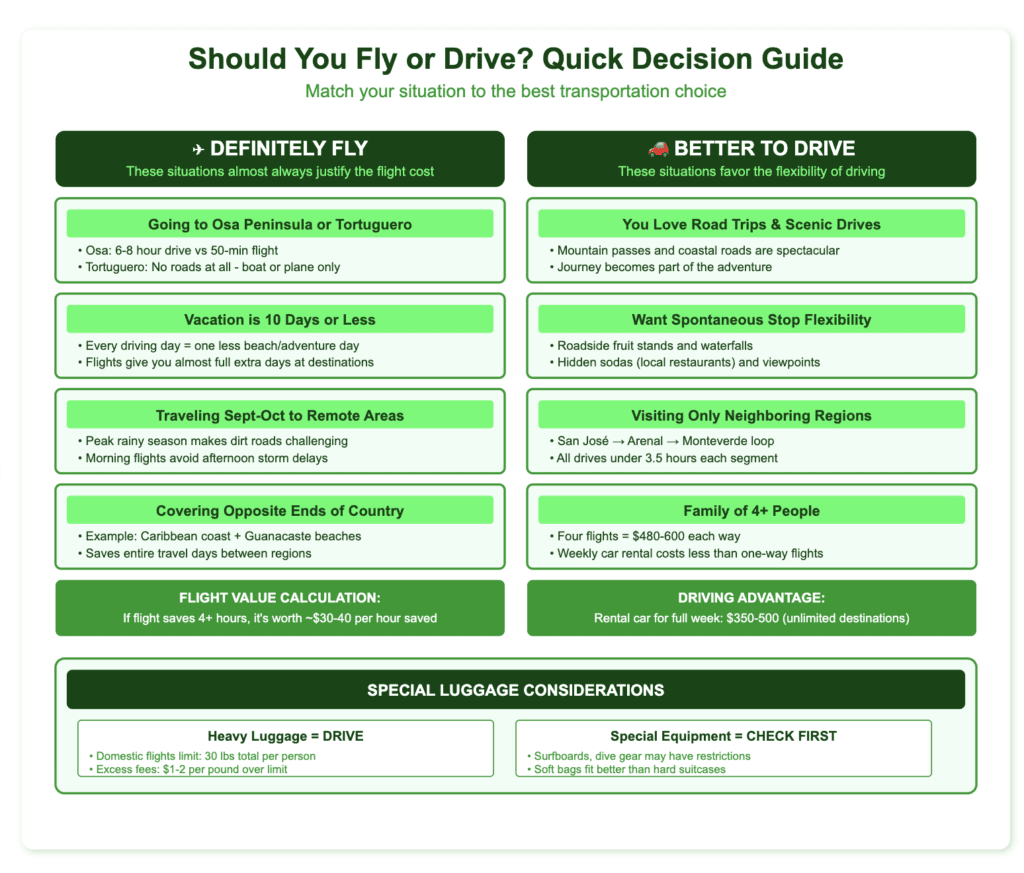
Ready to Add Flights to Your Costa Rica Adventure?
Here’s your action plan for incorporating domestic flights effectively:
- Map out your must-see destinations – Be realistic about what you can fit in
- Calculate actual driving times – Add 30% to Google’s estimates for Costa Rica roads
- Identify routes where flights save 3+ hours – These are your flight candidates
- Check availability on both airlines – Sansa and Green Airways sometimes have different schedules
- Book Osa and Tortuguero flights immediately – These sell out fastest
- Reserve rental cars for driving segments – Check our delivery fees to airports in the table below
Want more help planning your route? Check out our guides on Choosing the Right Costa Rica Airport for arrival options and Popular Road Trip Routes from SJO Airport to see how flights and drives can work together. If you’re traveling with children, consider how flight timing affects nap schedules and meal times.
The bottom line? Domestic flights in Costa Rica aren’t about luxury – they’re about being smart with your time. Sometimes that bumpy 30-minute flight beats a beautiful but exhausting 6-hour drive. Sometimes the drive itself is part of the adventure you’re seeking. Now you know enough to make the right call for your specific trip.
Remember, some of Costa Rica’s best moments happen between destinations – that’s the beauty of having options. Whether you fly or drive, the spectacular destinations remain the same. It’s just a matter of how you want to reach them.
¡Pura vida and happy travels!
